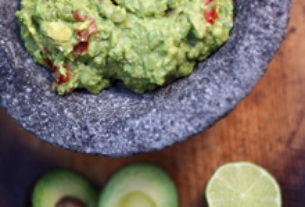Mexican Kitchen
One of the earliest food preparation techniques in many parts of the world was wrapping food in leaves and cooking it over an open fire, usually either steamed or roasted. In some instances, the food was baked in clay ovens or in pits dug in the ground. Cornhusks in Mexico, grape leaves in the eastern Mediterranean, jackfruit leaves in India and silverbeet leaves in Australia are all examples of leaf wraps.
Culinary pioneers employed whatever leaves were available, using them to keep the food from falling apart, to hold in moisture and flavor, and to prevent the food itself from burning. Perhaps nowhere was such a variety of leaves used this way as in ancient Mexico.
In the court of the Aztec Emperor Moctezuma, gastronomy was of utmost importance, and the Spanish chroniclers spared no ink in describing the court cuisine in great detail. We are told that over three hundred different dishes were prepared each day, and given a detailed list of the herbs, spices and leaves involved in this gastronomic feat.
The chroniclers seemed particularly fascinated with tamales, the quintessential leaf-wrapped food, and wrote about their various names and fillings for everyday and ritual occasions. (See Los Tamales: At the Heart of the Fiesta for Five Hundred Years, Mexico Connect, December 2001.) Dried cornhusks, fresh corn leaves ( hoja de milpa), avocado leaves, hoja santa (piper auritum) and even leaves from chile plants were used to wrap tamales.
The Maya, too, used leaf wraps for tamales, commonly employing banana leaves. Culinary anthropologist Sophie Coe wrote of Mayan tamal making that “in earlier times many other leaves were used, some of which, like the leaves of some kinds of avocados and the leaves of the Piper species, contributed their own flavor to the finished product. Gathering leaves in the forest was a male task. If he came back with suitable leaves, then tamales were made; if not, another form of breadstuff was substituted.”
The word tamal is used to refer to many types of leaf-wrapped food, not only the familiar corn dough tamales. Both the grilling and steaming of fish provide perfect venues for leaf-wrap cooking. The broad, flat, anise-flavored hoja santa leaves have long been used on the coasts of Veracruz and Oaxaca for cooking sea bass, snook and other species. On the Yucatan peninsula, banana leaves, favored in so much of the regional cuisine, provide a tasty wrap for pescado tik-n xic, whole grilled grouper or red snapper flavored with achiote paste and ground spices, as well as the traditional pork and chicken pibil dishes.
Zapotitlan, in southern Puebla, home of the annual autumn goat slaughter, or matanza, is famous for its barbacoa, in which the meat is cooked in avocado leaves. In the central Mexican states of Hidalgo, Tlaxcala, Puebla and Estado de Mexico, mixiotes are a regional specialty. These consist of bundles of meat marinated in a seasoning paste and wrapped in pencas de maguey, the inner layer of the maguey leaf. In recent years, due to the rapidly dwindling supply of maguey, papel para mixiotes, similar to parchment paper, has often been substituted.
Perhaps one of the most unusual leaf wrappings of all is the bird of paradise leaf, used in the mountainous area around Miahuatlan, in the state of Oaxaca. This exotic beauty grows wild on the mountain slopes, and local women take advantage of its abundance to wrap food for steaming. The leaves, like banana leaves, need to be softened over a flame to make them pliable enough for wrapping.
Leaf wrapping, since it involves baking, grilling or steaming, is a healthy method of food preparation since it requires no fat for frying. It can be used for meat, poultry and vegetables, and often imparts an additional layer of flavor. Los Danzantes restaurant in Oaxaca offers a tamal de mariscos, a tasty bundle consisting of a variety of seafood wrapped in an hoja santa leaf and tied with strips of cornhusk, a perfect example of the appeal to both eye and palate that can be achieved with leaf wrapping. Food can be cut up to fit the leaves and vice versa.
The following leaf-wrap recipes include the use of spinach, avocado, hoja santa and banana leaves as well as fresh and dried cornhusks. Spinach and hoja santa leaves are used fresh, banana leaves are passed over a flame to soften before wrapping food, and dried cornhusks are soaked in water to soften overnight, then drained and dried. Avocado leaves may be lightly toasted or not, depending on the recipe. These recipes require no special equipment, and the sight and aroma of the food being unwrapped for serving will impress family and friends as well as bringing a very authentic Mexican touch to a meal.
- Filetes de Pescado en Hoja Santa: Fish Filets in Hoja Santa
- Queso Fresco al Horno: Cheese Baked in Toasted Avocado Leaves
- Tamal de Higado: Chicken Livers Cooked in Corn Husks
- Chiltamales: Cornhusk Wrapped Chiles Stuffed with Fresh Corn
- Pílte de Pollo: Chicken Cooked in Avocado and Banana Leaves
- Mixiotes de Carnero: Spiced Lamb Steamed in Maguey Leaves
- Pescado Tikin-Xic: Yucatecan Baked Fish
- Pavo al Vapor en Recado Colorado: Steamed Turkey in Achiote
- Zanahorias al Vapor con Vainilla: Steamed Carrots with Vanilla
- Cochinita Pibil: Baked Marinated Pork
- Pollo Ticul: Yucatecan Style Chicken


